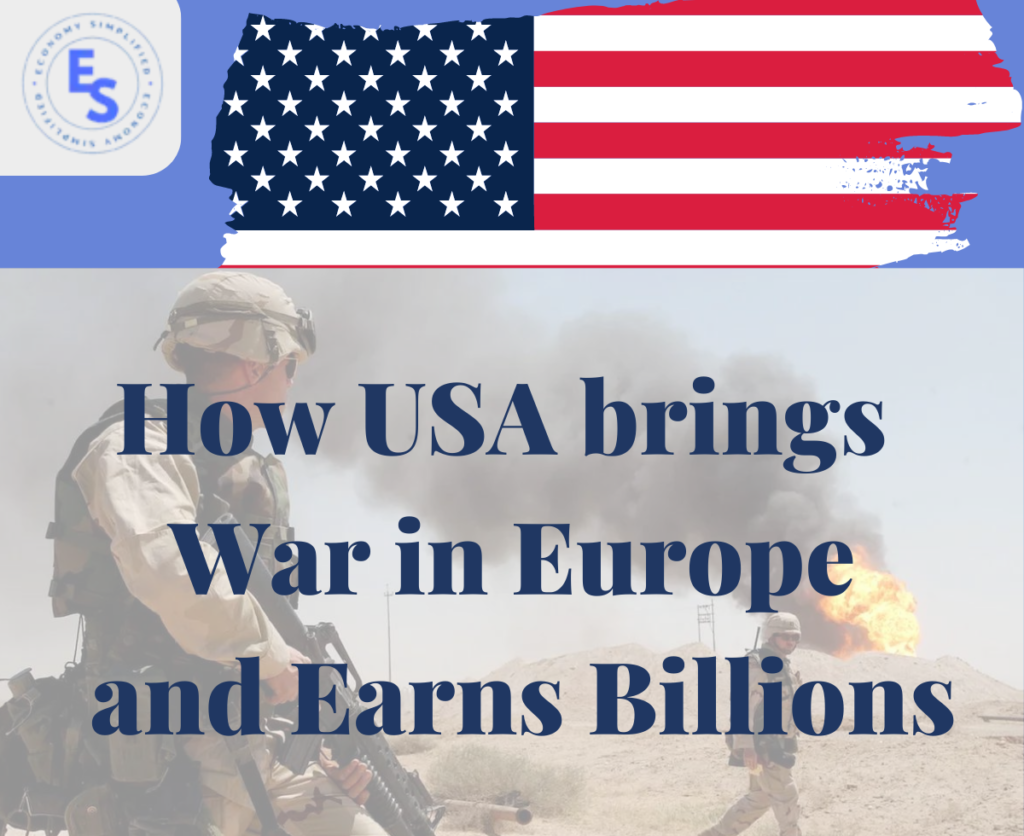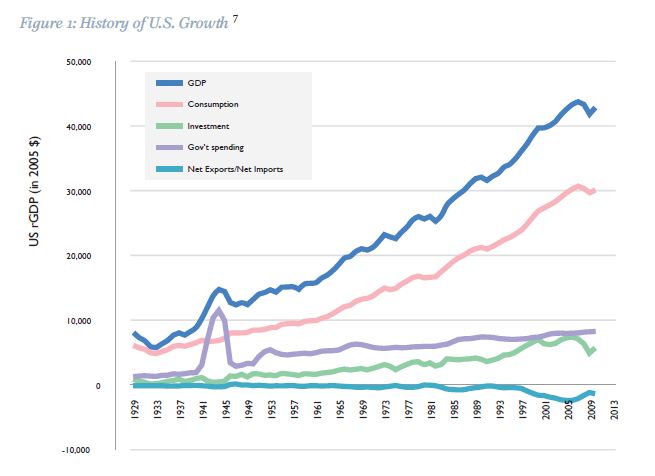How the USA brings War in Europe and Earns Billions

On one hand there are countries that create war and on the other are the countries who make profit out of it.
How USA brings War in Europe and Earns Billions it is observed that as the danger increases, US armament manufacturers observe a spike in European demand. As the tension increases between Russia and other nations, Europe becomes a new hotspot for arm imports
Why are wars necessary? How did America make money from the war in Europe?
Philosopher Henry Hegel claims that war is a “positive moment” in which the state establishes its rights and interests and expresses itself as an individual. Sacrifice on behalf of the ‘individuality’ of the state is the “substantial tie between the state and its members—and so is a universal duty.” One of the primary reason is the state is a more significant source of meaning than civil society since it actualizes freedom and advances spirit itself. The second justification for why wars are important is the decline in national corruption. And as corruption declines, the overall system operates more efficiently. According to Hegel, corruption will persist under normal circumstances, but when a country is at war, resources will be mobilised to defend the nation. He believes that fighting is a form of purging that demonstrates how important the state is to the lives of its people. In the international politics the realist perspective says that wars should keep happening periodically.
What is a war economy? The impact of war on economic growth
War economy is the state of contingencies undertaken by modern state to mobilize its economy for war production. Philippe Le Billon describes a war economy as a “system of producing, mobilizing and allocating resources to sustain the violence”. The main idea here is to distribute the resources in in a way that there is growth of war industries in the state.
What is Military Keynesianism, and how has it benefited the US economy?
The idea behind military Keynesianism is that government spending on the military should be increased in order to spur economic growth. It is a fiscal stimulus policy proposed by John Maynard Keynes.
It has been observed that war sometimes have and effect of accelerating technological progress to such a degree that an economy is greatly strengthened after it. On the supply side, it is asserted that by producing new infrastructure and cutting-edge technology, military research and development (R&D) spending raises the productivity of the civilian sector.
This the main reason why Unites states invests in high-end technology.
“If the Axis powers won, then we would have to convert ourselves permanently into a militaristic power on the basis of war economy.”- U.S. President Franklin Roosevelt during WWII.

Effects of World War II on U.S Economy
The war years of 1941 to 1945 saw one of the most significant short term increases in growth in the history of U.S. economy. Growth during this period was driven by government spending and accompanied by decline in consumption and investment in comparison to the pre-war trend.

The Effect of War on Government Spending
17 million new civilian jobs were generated during the war, industrial productivity rose by 96%, and corporation profits after taxes more than doubled. Over a third of industrial output was directly consumed by wartime requirements, but the increased productivity also insured that there was a phenomenal supply of consumer products for the general populace.
Real weekly wages in manufacturing were fifty percent greater in 1944 than they were in 1939 as a result of wage increases and overtime pay.
The war also gave rise to entirely new industries, technology, and associated human skills and abilities.
End of Cold War & Rising fears in Europe
Since the end of the Cold War, Russia has continued to spread the ideology of the USSR. Because of this, there is concern in Europe about Russia’s possible westward expansion to spread its ideology and further its interests. The United States has benefited most from this concern as it serves as the region’s security provider and reaps billions of dollars.
Present day
Since the 1960s, the United States has taken part in various military operations in the Middle East and Latin America. They have an annual military budget greater than many nations’ combined budgets since they have been at war nonstop since the September 11th attacks on the world trade centre. U.S. contributions to the fight under the banner that they are at war with terrorism did not end after the attack.
European’s Weapon Imports.
The Stockholm Peace Research Institute (SIPRI) reports that while the global trade in major weapons decreased by 4.6%, European nations boosted their acquisitions of armaments by 19%, the largest increase of any global region.
This was Europe’s response to Russia’s annexation of the Crimean Peninsula in 2014.
The U.S. steps in to save the day
With regard to combat aircraft in particular, the United States was by far the major provider to the Europeans. Together, the Netherlands, Norway, and the United Kingdom ordered 71 US F-35 aircraft. Added orders came from nations that felt particularly threatened by Russia in 2020/21: Finland and Poland ordered 64 and 32 F-35s, respectively. In the meantime, Germany placed an order with the US for five P-8A anti-submarine planes.
Conflicts with Iran & Paris Air show 2019
Nearly 400 American companies were exhibiting equipment at the 2019 Paris Air Show as the Persian Gulf standoff between the US and Iran drew closer.
Despite rising trade tensions between the United States and Europe, Lockheed Martin, Boeing, and other major armament manufacturers reported seeing an increase in demand for American weapons during the biennial air show.
Another important aspect, according to business executives and government representatives, is the growing anxiety over Iran’s missile development programme. “Iran is our best business development partner. Every time they do something like this, it heightens awareness of threat”.
Benefiting from Ukraine War
President Donald Trump of the United States authorised the transfer of $47 million worth of weaponry to Ukraine at the end of 2017.
Russia-watching organisations in Europe issued a warning that the action would prompt Vladimir Putin to escalate tensions in the area.
Even after Trump lost the election to Joe Biden for president, the United States kept selling weapons to Ukraine. When Putin launched the invasion of Ukraine on February 24, the military aid strategy was still in place, and the predictions came true. In order to defend itself against the Russian invasion, Ukraine now needs more weapons.
Joe Biden commanded the transfer of more weaponry worth $350 million to the Eastern European nation through the Foreign Assistance Act just two days after Russia invaded Ukraine.
Making Profits beyond Europe
The United States has been using arms sales, the most of which are second-hand, as bait to increase influence and infiltrate Southeast Asian nations for the past ten years under the guises of the Pivot to Asia and Indo-Pacific Strategy.
The United States has a reputation for creating the most cutting-edge weapons in the world.
Some nations and regions still consider some of its outmoded weapons to be of the highest calibre, therefore it is thought to be a good deal.
The South Korean government paid the U.S. military a steep sum of $130 million for more than a dozen Chinook CH-47D helicopters.
For the RQ-4 Global Hawk, the United States decided on Japan to maximise profits. Japan spent $528 on the acquisition, which cost 61.3 billion yen, and 13 billion yen a year on operation and maintenance.
Additionally, despite claiming that it opposes “Taiwan independence,” the United States continued to supply armaments to the island of Taiwan. At very astronomical costs, Kidd-class destroyers and Perry-class frigates of the US Navy were given to Taiwan.
Effects of USA’s Profiteering
Because the United States lacked control over its weapon transfers, some of them wound up on the illicit market and ultimately found their way into the hands of terrorists and other undesirable parties.
A research by the independent arms-tracking organisation Conflict Armament Research claims that certain weapons purchased by the US military in 2015 found their way into the hands of ISIS forces.
USA’s Agenda
Although the U.S. frequently sells these weapons under the pretence of preserving peace, it actually wants to start more wars so that US arms dealers may make more money.
U.S. arms companies and politicians have always been present, harvesting what they can at the expense of terror, homelessness, and the deaths of local people in conflicts ranging from the War in Afghanistan to the Syrian Crisis; from the Israeli-Palestinian dispute to the Russian-Ukrainian struggle.
FAQ’s
“Iron Dome air defence system” is developed by?
-Israel
- It is a short-range, ground-to-air, air defence system that includes a radar and Tamir missiles that track and neutralize any rockets or missiles aimed at Israeli’s targets.
- It is used for countering rockets, artillery & mortars as well as aircraft, helicopters and Aerial Vehicles (UAV).
- It is capable of being used in all weather conditions, including during the day and night.
- It was developed by the state-run Rafael Advanced defence system and Israel Aerospace and was deployed in 2011.
- Rafael claims a success rate of over 90%, with more than 2000 interceptions, however the success rate is over 80%.
Q.) Examine the use of war in International politics. Do you think there is no other way of International conduct?




